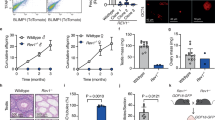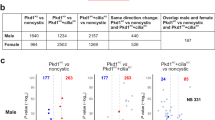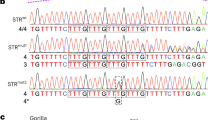Abstract
Meiotic arrest is a common pathologic phenotype of non-obstructive azoospermia (NOA), yet its genetic causes require further investigation. Meiotic nuclear divisions 1 (MND1) has been proved to be indispensable for meiotic recombination in many species. To date, only one variant of MND1 has been reported associated with primary ovarian insufficiency (POI), yet there has been no report of variants in MND1 associated with NOA. Herein, we identified a rare homozygous missense variant (NM_032117:c.G507C:p.W169C) of MND1 in two NOA-affected patients from one Chinese family. Histological analysis and immunohistochemistry demonstrated meiotic arrest at zygotene-like stage in prophase I and lack of spermatozoa in the proband’s seminiferous tubules. In silico modeling demonstrated that this variant might cause possible conformational change in the leucine zippers 3 with capping helices (LZ3wCH) domain of MND1-HOP2 complex. Altogether, our study demonstrated that the MND1 variant (c.G507C) is likely responsible for human meiotic arrest and NOA. And our study provides new insights into the genetic etiology of NOA and mechanisms of homologous recombination repair in male meiosis.
This is a preview of subscription content, access via your institution
Access options
Subscribe to this journal
Receive 12 print issues and online access
$259.00 per year
only $21.58 per issue
Buy this article
- Purchase on Springer Link
- Instant access to full article PDF
Prices may be subject to local taxes which are calculated during checkout



Similar content being viewed by others
References
Lotti F, Maggi M. Sexual dysfunction and male infertility. Nat Rev Urol. 2018;15:287–307.
Krausz C, Riera-Escamilla A. Genetics of male infertility. Nat Rev Urol. 2018;15:369–84.
Minhas S, Bettocchi C, Boeri L, Capogrosso P, Carvalho J, Cilesiz NC, et al. European Association of urology guidelines on male sexual and reproductive health: 2021 Update on Male Infertility. Eur Urol. 2021;80:603–20.
Kasak L, Laan M. Monogenic causes of non-obstructive azoospermia: challenges, established knowledge, limitations and perspectives. Hum Genet. 2021;140:135–54.
Agarwal A, Baskaran S, Parekh N, Cho CL, Henkel R, Vij S, et al. Male infertility. Lancet (Lond, Engl). 2021;397:319–33.
Houston BJ, Riera-Escamilla A, Wyrwoll MJ, Salas-Huetos A, Xavier MJ, Nagirnaja L, et al. A systematic review of the validated monogenic causes of human male infertility: 2020 update and a discussion of emerging gene-disease relationships. Hum Reprod update. 2021;28:15–29.
Ji Z, Yao C, Yang C, Huang C, Zhao L, Han X, et al. Novel Hemizygous Mutations of TEX11 Cause Meiotic Arrest and Non-obstructive Azoospermia in Chinese Han Population. Front Genet. 2021;12:741355.
Li P, Ji Z, Zhi E, Zhang Y, Han S, Zhao L, et al. Novel bi-allelic MSH4 variants causes meiotic arrest and non-obstructive azoospermia. Reprod Biol Endocrinol: RBE. 2022;20:21.
Chen M, Yao C, Qin Y, Cui X, Li P, Ji Z, et al. Mutations of MSH5 in nonobstructive azoospermia (NOA) and rescued via in vivo gene editing. Signal Transduct Target Ther. 2022;7:1.
Yao C, Yang C, Zhao L, Li P, Tian R, Chen H, et al. Bi-allelic SHOC1 loss-of-function mutations cause meiotic arrest and non-obstructive azoospermia. J Med Genet. 2021;58:679–86.
Al-Agha AE, Ahmed IA, Nuebel E, Moriwaki M, Moore B, Peacock KA, et al. Primary Ovarian Insufficiency and Azoospermia in Carriers of a Homozygous PSMC3IP Stop Gain Mutation. J Clin Endocrinol Metab. 2018;103:555–63.
Xie X, Murtaza G, Li Y, Zhou J, Ye J, Khan R, et al. Biallelic HFM1 variants cause non-obstructive azoospermia with meiotic arrest in humans by impairing crossover formation to varying degrees. Hum Reprod (Oxf, Engl). 2022;37:1664–77. in press
Cioppi F, Rosta V, Krausz C. Genetics of Azoospermia. Int J Mol Sci. 2021;22:3264.
Zickler D, Kleckner N. Recombination, Pairing, and Synapsis of Homologs during Meiosis. Cold Spring Harb Perspect Biol. 2015;7:a016626.
Hunter N. Meiotic Recombination: The Essence of Heredity. Cold Spring Harb Perspect Biol. 2015;7:a016618.
Brown MS, Bishop DK. DNA strand exchange and RecA homologs in meiosis. Cold Spring Harb Perspect Biol. 2014;7:a016659.
Shah SS, Hartono S, Piazza A, Som V, Wright W, Chédin F, et al. Rdh54/Tid1 inhibits Rad51-Rad54-mediated D-loop formation and limits D-loop length. eLife. 2020;9:e59112.
Pezza RJ, Voloshin ON, Volodin AA, Boateng KA, Bellani MA, Mazin AV, et al. The dual role of HOP2 in mammalian meiotic homologous recombination. Nucleic acids Res. 2014;42:2346–57.
Saito TT, Tougan T, Kasama T, Okuzaki D, Nojima H. Mcp7, a meiosis-specific coiled-coil protein of fission yeast, associates with Meu13 and is required for meiotic recombination. Nucleic acids Res. 2004;32:3325–39.
Kerzendorfer C, Vignard J, Pedrosa-Harand A, Siwiec T, Akimcheva S, Jolivet S, et al. The Arabidopsis thaliana MND1 homologue plays a key role in meiotic homologous pairing, synapsis and recombination. J Cell Sci. 2006;119:2486–96.
Lu J, Wang C, Wang H, Zheng H, Bai W, Lei D, et al. OsMFS1/OsHOP2 complex participates in rice male and female development. Front Plant Sci. 2020;11:518.
Jolly A, Bayram Y, Turan S, Aycan Z, Tos T, Abali ZY, et al. Exome sequencing of a primary ovarian insufficiency cohort reveals common molecular etiologies for a spectrum of disease. J Clin Endocrinol Metab. 2019;104:3049–67.
Pettersen EF, Goddard TD, Huang CC, Meng EC, Couch GS, Croll TI, et al. UCSF ChimeraX: Structure visualization for researchers, educators, and developers. Protein Sci: a Publ Protein Soc. 2021;30:70–82.
Mirdita M, Schütze K, Moriwaki Y, Heo L, Ovchinnikov S, Steinegger M. ColabFold: Making protein folding accessible to all. Nat methods. 2022;19:679–82.
Jumper J, Evans R, Pritzel A, Green T, Figurnov M, Ronneberger O, et al. Highly accurate protein structure prediction with AlphaFold. Nature. 2021;596:583–9.
Shapovalov MV, Dunbrack RL Jr. A smoothed backbone-dependent rotamer library for proteins derived from adaptive kernel density estimates and regressions. Struct (Lond, Engl: 1993). 2011;19:844–58.
Becherel OJ, Fogel BL, Zeitlin SI, Samaratunga H, Greaney J, Homer H, et al. Disruption of Spermatogenesis and Infertility in Ataxia with Oculomotor Apraxia Type 2 (AOA2). Cerebellum (Lond, Engl). 2019;18:448–56.
Becherel OJ, Yeo AJ, Stellati A, Heng EY, Luff J, Suraweera AM, et al. Senataxin plays an essential role with DNA damage response proteins in meiotic recombination and gene silencing. PLoS Genet. 2013;9:e1003435.
Rabitsch KP, Tóth A, Gálová M, Schleiffer A, Schaffner G, Aigner E, et al. A screen for genes required for meiosis and spore formation based on whole-genome expression. Curr Biol: CB. 2001;11:1001–9.
Tsubouchi H, Argunhan B, Ito K, Takahashi M, Iwasaki H. Two auxiliary factors promote Dmc1-driven DNA strand exchange via stepwise mechanisms. Proc Natl Acad Sci USA. 2020;117:12062–70.
Pezza RJ, Voloshin ON, Vanevski F, Camerini-Otero RD. Hop2/Mnd1 acts on two critical steps in Dmc1-promoted homologous pairing. Genes Dev. 2007;21:1758–66.
Zhao W, Sung P. Significance of ligand interactions involving Hop2-Mnd1 and the RAD51 and DMC1 recombinases in homologous DNA repair and XX ovarian dysgenesis. Nucleic acids Res. 2015;43:4055–66.
Gerton JL, DeRisi JL. Mnd1p: An evolutionarily conserved protein required for meiotic recombination. Proc Natl Acad Sci USA. 2002;99:6895–900.
Kang HA, Shin HC, Kalantzi AS, Toseland CP, Kim HM, Gruber S, et al. Crystal structure of Hop2-Mnd1 and mechanistic insights into its role in meiotic recombination. Nucleic acids Res. 2015;43:3841–56.
Zhao W, Saro D, Hammel M, Kwon Y, Xu Y, Rambo RP, et al. Mechanistic insights into the role of Hop2-Mnd1 in meiotic homologous DNA pairing. Nucleic acids Res. 2014;42:906–17.
Crickard JB, Kwon Y, Sung P, Greene EC. Dynamic interactions of the homologous pairing 2 (Hop2)-meiotic nuclear divisions 1 (Mnd1) protein complex with meiotic presynaptic filaments in budding yeast. J Biol Chem. 2019;294:490–501.
Alber T. Structure of the leucine zipper. Curr Opin Genet Dev. 1992;2:205–10.
Tran TN, Martinez J, Schimenti JC. A predicted deleterious allele of the essential meiosis gene MND1, present in ~ 3% of East Asians, does not disrupt reproduction in mice. Mol Hum Reprod. 2019;25:668–73.
Tran TN, Schimenti JC. A putative human infertility allele of the meiotic recombinase DMC1 does not affect fertility in mice. Hum Mol Genet. 2018;27:3911–8.
Singh P, Schimenti JC. The genetics of human infertility by functional interrogation of SNPs in mice. Proc Natl Acad Sci USA. 2015;112:10431–6.
Acknowledgements
We would like to thank the proband and his family for their participation in the study. And we would like to thank Prof. Yuchuan Zhou for his kind contributions on revising this manuscript. This work was supported by National Key Research and Development Program of China (2022YFC2702701); National Natural Science Foundation of China (82001530, 82171597 and 81871215); Shanghai science and technology innovation action plan project (20Y11907600); Clinical Research Innovation Plan of Shanghai General Hospital (CTCCR-2021C17); Shanghai Sailing Program (20YF1439500); Shanghai Key Laboratory of Embryo Original Diseases (Shelab2021ZD01) and Postgraduate Research & Practice Innovation Program of Jiangsu Province (SJCX22_0676). Molecular graphics and analyses in Fig. 3 and Table S2 were performed with UCSF ChimeraX which was developed by the Resource for Biocomputing, Visualization, and Informatics at the University of California, San Francisco, with support from National Institutes of Health R01-GM129325 and the Office of Cyber Infrastructure and Computational Biology, National Institute of Allergy and Infectious Diseases, and the three-dimensional protein structures in Fig. 3A were predicted using Colabfold on Google Colab.
Author information
Authors and Affiliations
Contributions
All authors contributed to the study conception and design. PL, CCY and ZL designed the research; JPZ and ZYJ performed the research; Clinical data were collected by JQL, YXZ, NJO and HWB. Clinical samples were collected and prepared by RHT, YHH, ELZ and NCL. GQM, WBH, and YQT performed the bioinformatics analysis; JPZ, JZY, CCY, PL and ZL wrote and revised the manuscript. All authors read and approved the final manuscript.
Corresponding authors
Ethics declarations
Competing interests
The authors declare no competing interests.
Ethical approval
This study was approved by the Institutional Ethical Review Committee of Shanghai General Hospital, Shanghai Jiao Tong University (Permit Number: 2020SQ199), and an informed consent of clinical data and testicular tissues for research was obtained from the donors.
Consent to participate
Informed consent was obtained from all individual participants included in the study.
Consent for publication
The authors affirm that human research participants provided informed consent for publication of the images in Figure(s) 1A, B, C, 2 and Table(s) 1 and 2.
Additional information
Publisher’s note Springer Nature remains neutral with regard to jurisdictional claims in published maps and institutional affiliations.
Supplementary information
Rights and permissions
Springer Nature or its licensor (e.g. a society or other partner) holds exclusive rights to this article under a publishing agreement with the author(s) or other rightsholder(s); author self-archiving of the accepted manuscript version of this article is solely governed by the terms of such publishing agreement and applicable law.
About this article
Cite this article
Zhao, J., Ji, Z., Meng, G. et al. Identification of a missense variant of MND1 in meiotic arrest and non-obstructive azoospermia. J Hum Genet 68, 729–735 (2023). https://doi.org/10.1038/s10038-023-01172-y
Received:
Revised:
Accepted:
Published:
Issue Date:
DOI: https://doi.org/10.1038/s10038-023-01172-y



